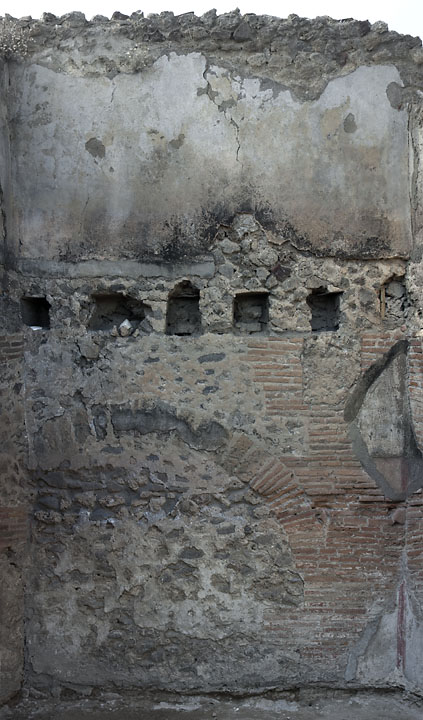North Wall
Description
Susanna Blåndman
The north wall is a partition wall of the taberna, marking the north boundary to V 1,3. The wall contains several details such as an arch in the lower half and six beam holes in the upper half. A walled-up window points toward two construction phases in the wall. The wall is built in opus mixtum with opus incertum in the west part and opus testaceum in the east part. The uppermost courses of the opus incertum, above the large patch of plaster, are a modern reconstruction. Scant remains of a cocciopesto floor abut the wall in a few places along the wall.
Opus testaceum
The east part of the wall, a 0.64 - 0.80 m wide area starting at the height of 0.25 m and ending at the height of 2.80 m, is built in opus testaceum. A few longer tongues, 1.02 - 1.29 m long, are stretching into the opus incertum in the west part of the wall.The bricks are 0.05 - 0.34 m long and 0.03 - 0.05 m thick, most of them are long. The opus testaceum does not form a regular pattern since several brick courses abut both the arch and the walled-up window and therefore vary in length.
Opus incertum
The west part of the wall, a 2.15 - 2.31 m wide area, is built in opus incertum and consists mainly of lava pieces but there are also several Sarno stones, one block of tufa and one cruma.
The walled-up splay window
The walled-up window is placed in the east part of the wall, at the height of 2.28 m and at a distance of 2.20 m from the west corner. It is 0.52 m high and 0.45 m wide and it has been filled in antiquity with stones and mortar. The window is located directly under a beam hole. The window is also visible in the south wall in room 2, in V1,3, where it is smaller.
The arch
The arch is partly covered by supporting plaster but the contours are still visible. The lower west end of the arch is located at the height of 1.88 m in the west corner and the lower east end at the height of 1.21 m and at a distance of 0.65 m from the east corner of the wall. The highest point of the arch is located at a distance of 0.88 m from the west corner and at the height of 2.36 m. The western part of the arch, a 1.97 m wide area, is built of rectangular blocks of tufa and Sarno stones. They are 0.26 - 0.30 m long and 0.08 - 0.12 m thick. The remaining eastern part is built of bricks. They are 0.26 - 0.30 m long and 0.03 - 0.05 m thick. No specific function was found for the arch.
The beam holes
There are six beam holes in the wall, located at the height of 2.85 - 2.95 m. All holes are either damaged or to some extent reconstructed, which makes conclusions about their level and size uncertain. The height of the holes varies between 0.25 - 0.30 m and they are 0.15 - 0.30 m wide. The easternmost hole has been filled in modern times with stones, bricks and mortar, making it difficult to decide on its original level. The holes do not penetrate the wall and looking from the other side of the wall, inside V 1 3, room a, there are no traces of beam holes. All beam holes except one have imprints of beams in the partly remaining mortar. In those beam holes there are also a thin layer of ash.
There is only one spolium in the wall, a fragment of terracotta. The mortar is brownish and containing grains of lava. The mortar is modern from the height of 1.49 m and up to 1.79 m in a 0.90 m wide area close to the west corner.
Four patches of wall plaster still remain in situ. Two patches of fine wall plaster are located in the east corner, at the height of 0.12 m and at the height of 1.61 m. The lowermost patch is 0.82 m high and 0.05 - 0.35 m wide; the upper patch is 1.03 m high and 0.05 - 0.39 m wide. They are heavily weathered and no colour remains except for a 0.030 - 0.038 m wide vertical red stripe in the corner. This stripe is also found on the corresponding patches on the east wall. It ends at the same height as on the east wall. The upper patch is not as dirty as the corresponding patch on the east wall. The lower part of it has a reddish brown surface and the upper part of it is whitish / greyish. The lowest patch is whitish but also badly worn. Both patches are supported by modern plaster.
At the height of 3.45 m there is a 2.95 m wide and up to 1.55 m high patch of fine wall plaster that covers a large part of the wall of the upper floor. The plaster is badly worn and there are no traces of decorations. It is however possible to see minor traces of a yellow finishing. Smaller remains of the same patch are also preserved on the west wall. The patch is partly supported by modern plaster. There are also minor patches of supporting plaster on the wall. At the height of 4.35 m there is a 0.20 m high patch of debris from the eruption in the west corner.
H: 5.05 m (E); 5.10 m (W). L: 2.95 m

